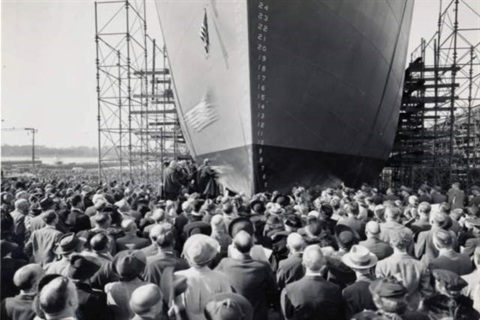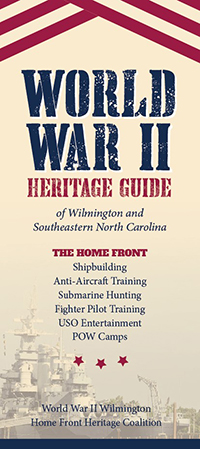World War II City

On Sept. 2, 2020, the City of Wilmington was officially named the first World War II Heritage City in the country.
This national designation recognizes the countless contributions of the women and men who stepped into the workforce to support America’s successful campaign during World War II and the effort taken to preserve the rich history.
Wartime Contributions
During World War II, Wilmington was known as “The Defense Capital of the State” for several reasons. Wilmington’s largest employer, the North Carolina Shipbuilding Company, constructed 243 cargo vessels. Strategic defense industries included fertilizer plants, pulpwood, creosote products, dairies, and concrete floating dry dock manufacturing. Wilmington was the site of the Atlantic Coast Line Railroad headquarters and a P-47 fighter plane training area.
The city and its surrounding area hosted training for all five military branches and the British Navy.
The city’s population more than doubled with the influx of military personnel forcing everyone to cope with a strain on housing, schools, transportation, the food supply, medical and social services. Thousands of Wilmingtonians joined the fight as Navy frogmen, P-51 fighter aces, Tuskegee Airmen, submarine skippers, bomber pilots, Marine riflemen, Army artillerymen, physicians, nurses and volunteers. Learn more about why Wilmington was named a World War II Heritage City(PDF, 6MB).
An Earned Honor
New Hanover County tragically lost 248 men as a result of their courageous efforts to defend America. Two New Hanover High School graduates received the Congressional Medal of Honor: Charles P. Murray, Jr., Army, (1938); and William D. Halyburton, Jr., Navy, (1943). Numerous others received decorations for valor including Navy Crosses, Distinguished Service Crosses and Distinguished Flying Crosses.
Retired Navy Captain Wilbur Jones used his role as a historian and the chairman of the World War II Wilmington Home Front Heritage Coalition, to request local and state leaders support a nationally recognized designation honoring and preserving the wartime impact of the city. Learn more about the city's 12-year project to become the first World War II Heritage City(PDF, 6MB).
Based on the region’s vast contributions to the war effort, its strategic location, and the record of its residents serving in uniform, President Donald Trump officially named the City of Wilmington an "American World War II Heritage City" on September 2, 2020, during a ceremony at the USS North Carolina.
Preservation Efforts
Much has been done to preserve Wilmington's historic contributions to World War II. Preservation efforts are a key determinant in receiving the World War II Heritage City designation. Wilmington's preservation efforts include the following:
- Housing the Battleship North Carolina, the state’s memorial to those who lost their lives in WWII. Moored here since 1961 on the Cape Fear River across from downtown, the battleship is a national treasure and attraction
- Forming the World War II Wilmington Home Front Heritage Coalition in 2001. A 501(c)(3) non-political, all-volunteer preservation, the organization's mission is to identify, preserve, and interpret the rich WWII legacy of Wilmington and Southeastern N. C. The coalition conceived and led the 12.5-year project toward Wilmington’s designation as the first American World War II Heritage City
- Saving, preserving, renovating, and restoring the Hannah Block Historic USO/Community Arts Center, which is the area’s WWII activity hub and a perfect blending of history and the arts. The lobby is restored to its 1943 appearance with original and repro furniture and furnishings
- Dedicating memorials to the 248 New Hanover County-connected dead soldiers in the HBHUSO/CAC lobby museum
- Dedicating exhibits and artifacts to outstanding local veterans and the National WWII Memorial giclée.
- Honoring New Hanover High School’s two graduates WWII Medal of Honor recipients by naming a school and city park for Murray Jr., and Halyburton Jr., and erecting memorials at New Hanover High School and the HBHUSO/CAC
- Erecting historical markers, including for two German prisoner of war camps, and the German U-Boat firing on the Ethyl-Dow chemical plant at Kure Beach in 1943.
- Holding annual Pearl Harbor anniversary commemorations annually on Dec. 7
- Publishing and distributing three editions of the “World War II Heritage Guide Map of Wilmington and Southeastern North Carolina.”
Visit the Museum
From 1941 to 1945, the 24-hour USO at Second and Ann streets hosted big-band dances, plays, lectures, radio broadcasts and home-cooked meals. Today, the Hannah Block Historic USO lobby is restored to its wartime appearance and serves as a mini museum where WWII home front memorabilia and artifacts are displayed.
 (PDF, 3MB)
(PDF, 3MB)